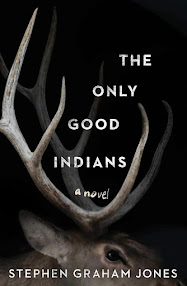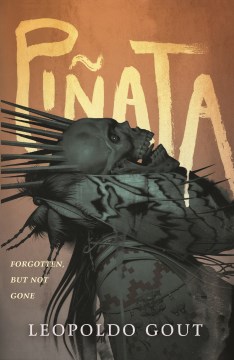Author: Stephen Graham Jones
Title: The Only Good Indians
Genre: Emotion (Horror)
Publication Date: 2020
Number of Pages: 310
Geographical Setting: Montana, North Dakota, Blackfeet reservations
Time Period: Present Day
Plot Summary: Four Blackfeet men, once close childhood friends, grapple with the poverty, drug abuse, and crime on their reservation in different ways. None of them can truly shake the literal or metaphorical ghosts of their pasts. They are each pursued by an entity of their own creation, borne from a misguided hunting trip on forbidden land.
As the mysterious being continues its killing spree, it orchestrates a grand finale. The men are drawn back towards each other, forced to confront what it means have ever wanted to leave the reservation and tradition behind.
Subject Headings (per Novelist):
- American people
- Belief and doubt
- Elk
- Families
- Guilt
- Hunting
- Identity
- Indigenous men
- Indigenous peoples of North America
- Indigenous reservations
- Intergenerational trauma
- North American people
- Revenge
- Rural life
- Siksika (North American people)
- Tradition (Philosophy)
Horror Appeals:
Tone - "The atmosphere in Horror novels must evoke an emotional response: dread and chill, a sense of menace, a feeling of terror" (Wyatt & Saricks, 2019)
Jones' book creeps into the reader's psyche, dangling dread like a carrot to a horse, until the readers practically begs for the pin to drop. The stage is set early on with sections of the book receiving titles like "The House that Ran Red" and "Sweat Lodge Massacre" (Jones, 2020). One of the doomed men in the book, Lewis, has left his reservation behind to marry a white woman and pursue work at the post office. He orbits a Crow woman, Shaney, and dips into her knowledge as a fellow Indigenous person to unravel the visions he's seeing of a dead elk. The situation with Shaney escalates so gradually the reader is almost unaware of it at first, until Lewis has attributed his mental decay to Shaney's presence, and much blood is spilled in very fast succession by Lewis' hand. Jones allows his character Lewis to entertain multiple theories about his mental troubles -- perhaps his wife is possessed, perhaps the elk he shot had never died at all, perhaps it is possessing Shaney. The stakes accelerate at a breakneck pace, until they madden both Lewis and the reader, until the sweet release of the anticipated bloodshed.
Framing - "...the conventions and characters of the genre...come with baked-in elements that readers have also learned to expect and look for...such details also carry the story forward and create (or subvert) the key elements of the plot" (Wyatt & Saricks, 2019).
At its core, if one were to strip The Only Good Indians of its cultural context and place it in a sociopolitical vacuum, one would find a monster story. Like many monster stories, the beast kills and kills until it stands before a final victim. Genre convention would have this remaining character either best the monster, or be killed, allowing the reader to extrapolate their own sinister epilogue. In many ways, (spoiler alert!) The Only Good Indians follows these genre conventions. Elk Head Woman, the eponymous monster, leaves a trail of carnage in her wake, as vengeance for her forbidden killing while she was pregnant with an unborn calf. The four original men have been killed, leaving only Gabriel's "calf", teenaged Denorah, and another teenager sent to get help. The moment of the final confrontation with Elk Head Woman arrives, Denorah seemingly hopeless, until the other teenager arrives with help. Genre convention would have Elk Head Woman slaughtered, punished for her crimes. But the narrative takes a different turn. Denorah opts to spare Elk Head Woman, ending the cycle of violence. Elk Head Woman returns to her original completely elk form, her dead calf now alive beside her, and leaves to rejoin the herd. Denorah thus symbolically breaks free of the intergenerational trauma that plagued her father and his friends, and is able to lead a fulfilling life.
Characterization - "The main protagonists in these books are usually haunted, shattered individuals" (Wyatt & Saricks, 2019).
The four main men who dominate this story are classic horror characters trying (and failing) to outrun their pasts. All of them are cursed by their foray into the elders' sacred hunting ground, and travel there by truck rather than on traditional foot, further compounding their sins. Ricky and Lewis both try to build lives outside the reservation, but cannot escape their own traumas or the perceptions of others. Cassidy is on the precipice of turning his life around, but is still judged by his father. Gabriel has lost custody of his daughter and is addicted to multiple substances. The narrative voice connecting all four suggests that had they stuck together, and not split after their hunting trip, perhaps they could have weathered this storm together.
Three terms that best describe this book:
- Richly detailed
- Thought-provoking
- Unsettling
Fiction Read-alikes:
Gout, L. (2023). Piñata. New York: Tor Nightfire.
Common appeals: Own voices, North American people, richly detailed.
Hearts of the Missing by Carol Potenza
Common appeals: Indigenous peoples of North America, violation of sacred laws, strong sense of place.
Sisters of the Lost Nation by Nick Medina
Medina, N. (2023). Sisters of the lost nation. New York: Berkley
Common appeals: Indigenous reservations, identity, intergenerational trauma
Nonfiction Read-alikes:
Colwell, C. (2019). Plundered skulls and stolen spirits. Chicago: University of Chicago Press.
Common appeals: Intergenerational trauma, modern Indigenous lives, Indigenous spirituality
Living Ghosts & Mischievous Monsters by Dan Sasuweh Jones
Jones, D. S. (2021). Living ghosts and mischievous monsters. New York: Scholastic Nonfiction.
Common appeals: Indigenous spirituality, Indigenous lives, modern Indigenous people
American Indian Ghost Stories of the West by Antonio R. Garcez
Garcez, A. R. (2010). American Indian ghost stories of the west. Red Rabbit Press LLC.
Common appeals: Indigenous ghost stories, hauntings, own voices
References
Jones, S. G. (2020). The only good Indians. New York: Saga Press.
Wyatt, N., & Saricks, J. G. (2019). The readers' advisory guide to genre fiction. American Library Association.








Hi Grace. This looks like a scary read. For some reason the tv show Yellowstone kept popping in my mind when I read your review. There are several native Americans on that show, I pictured their characters in your review. I look forward to reading this. Great post!
ReplyDeleteI liked your wordplay when describing tone. It fleshed out the review. For example, "Jones' book creeps into the reader's psyche, dangling dread like a carrot to a horse, until the readers practically begs for the pin to drop." The non-fiction books were good picks too!
ReplyDelete